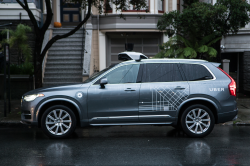— The NTSB Uber report of a self-driving car crash that killed an Arizona woman has been released in its preliminary version that shows the modified 2017 Volvo XC90 SUV had its automatic emergency braking feature disabled.
The National Transportation Safety Board says its preliminary report doesn't include a probable cause for the fatal crash, and current information could change as the investigation continues.
The NTSB’s preliminary report says the pedestrian, 49-year-old Elaine Herzberg, ignored the crosswalk signs and walked her bike onto the road. The bike had no side reflectors and the front and rear reflectors faced away from the self-driving Volvo.
Furthermore, Herzberg's toxicology tests came back positive for marijuana and methamphetamine.
Video of the crash shows she was wearing dark clothing and didn't look in the direction of the SUV until a second or so before impact.
The 2017 Volvo XC90 had been modified by Uber to include a self-driving system comprised of cameras, radars, LIDAR (light detection and ranging) and navigation sensors. Although the SUV was operating in self-driving mode, a female operator (monitor) was sitting behind the wheel when the crash occurred.
The report says the inclusion of the human operator is why Volvo's standard safety features such as collision avoidance and automatic emergency braking features were disabled. Uber says it chose to disable those safety features when a vehicle was in self-driving mode operated by the computer.
Uber also says it disabled the features in self-driving mode because the human monitor behind the wheel was expected to intervene if problems occur, something the operator obviously didn't do. The NTSB report says Uber's thinking was that having the safety features active in self-driving mode would only cause the SUV to perform erratically on the road.
According to investigators, data from the SUV indicates the self-driving system first noticed Elaine Herzberg about six seconds before impact as the Volvo was traveling 43 mph. The combination of radar and LIDAR identified Herzberg first as an unknown object, then as a vehicle and finally as a bicycle.
At 1.3 seconds before impact, the self-driving system determined that emergency braking was needed to reduce the severity of a collision, something not possible with the feature disabled.
Investigators found the woman behind the wheel grabbed the steering wheel less than one second before impact and hit the brake pedal less than one second after impact.
During interviews with the NTSB, the operator said she wasn't playing with her personal or business phone during the incident. Instead, she told investigators she was looking down at the self-driving interface as the SUV approached Herzberg.
Arizona had welcomed Uber to the state with open arms and little regulation, but the fatal crash convinced Arizona's governor to suspend Uber's license to test autonomous technology on the roads. This was followed by Uber's decision to shut down all self-driving operations in the state to focus on autonomous projects in Pittsburgh and San Francisco.
Investigators are still collecting information about all aspects of the Arizona crash, but CarComplaints.com will update our website when the NTSB releases its final report.

